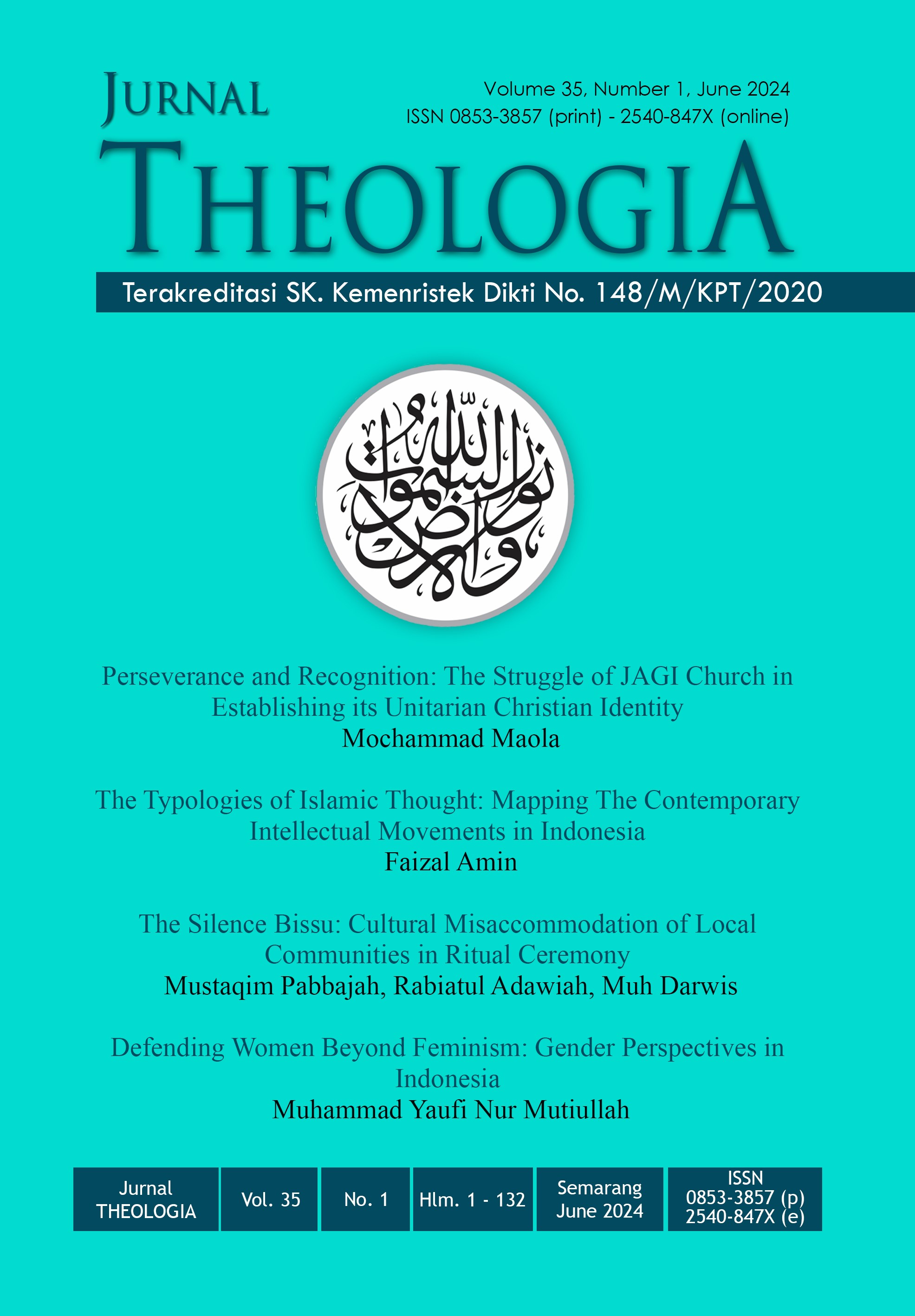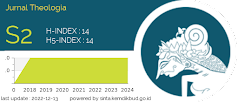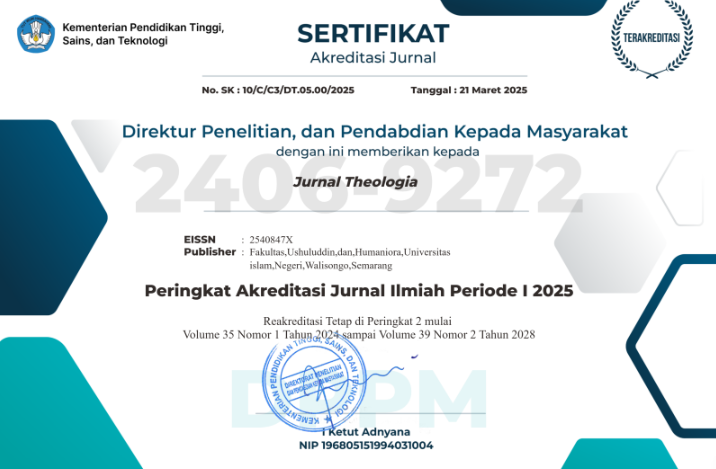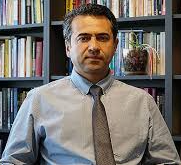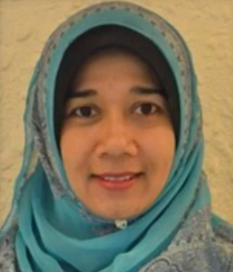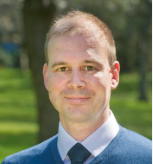The Contribution of West Kalimantan Sufi Scholars In Promoting Community Resilience: The Great Works of The Sufis to Fulfill the Basic Needs of Societies
DOI:
https://doi.org/10.21580/teo.2024.35.1.21490Keywords:
Works of Sufis, West Kalimantan, Social ResilienceAbstract
West Kalimantan is known as a region that produces Sufism thought, which is widely developed and utilized in various areas in Indonesia and the world. It can be seen from their great works in the form of books and development applications that they have created, even in integrating congregations. This research aims to reveal the works of West Kalimantan Sufism Ulama related to their efforts to build social, national and state resilience. The study is carried out over a long period, from 2012 to 2021. Several articles have been published in scientific journals and in book form. The research was conducted using a biographical approach through stories about their activities, the books they wrote, and other works still useful today. The study results show that Sufism scholars in West Kalimantan have their way of responding to changing times. The results of this work can be applied to Indonesia, which continues to grow towards becoming a developed and authoritative country.Downloads
References
A’dam, Syahrul. “ETOS EKONOMI KAUM TAREKAT SHIDDIQIYYAH.” Al-Iqtishad 3, no. 2 (2011): 313–30.
Abdrurrahman Abror. Pantun Melayu: Titik Temu Islam Dan Budaya Lokal Nusantara. Yogyakarta: LKiS, 2009.
Abdulloh, Muhammad. “Dakwah Kultural Dalam Bingkai Toleransi Agama (Studi Di Kampung Panca Mulya Kecamatan Banjar Baru Kabupaten Tulang Bawang Lampung).” Tesis. Universitas Islam Negeri Sunan Ampel Surabaya, 2018.
Akhiyat. “Tasawuf Dan Akulturasi Budaya: Telaah Tasawuf Dalam Perspektif Culture and Education.” Jurnal As-Salam 1, no. 1 (2016): 1–17. http://jurnal-assalam.org/index.php/JAS/article/view/40.
Atamimi, Abdul Basit, and Aip Syarifudin. “Mengkaji Pemikiran Tasawuf Kiai Ahmad Rifa`I Kalisalak Dalam Kitab Tarajumah.” An-Nufus 2, no. 1 (2020): 1–38. https://doi.org/10.32534/annufus.v2i1.1687.
Baidillah Riyadhi. Guru Haji Ismail Mundu: Ulama Legendaris Dari Kerajaan Kubu. Kubu Raya: Dinas Kebudayaan Pariwisata Pemuda dan Olah Raga, 2011.
Darmadi, Hamid. “Dayak and Their Daily Life.” JETL (Journal Of Education, Teaching and Learning) 2, no. 1 (2017): 101. https://doi.org/10.26737/jetl.v2i1.145.
———. “Dayak Asal-Usul Dan Penyebarannya Di Bumi Borneo.” Sosial Horizon 3, no. 2 (2016): 322–40.
Effendi, Muhammad Zulkham, and Asep Yudha Wirajaya. “Kajian Resepsi Terhadap Teks Futūhu ’l-‘Ārifīn.” Jumantara: Jurnal Manuskrip Nusantara 10, no. 2 (2019): 209–24. https://doi.org/10.37014/jumantara.v10i2.534.
Elmansyah; Saimi bin Bujang; Muhammed Sahrin bin Haji Masri. “SUFISM AND MILLENNIAL GENERATION.” Al Albab 8, no. 1 (2019): 43–56. https://doi.org/https://doi.org/10.24260/alalbab.v8i1.1272.
Fahmi, Moch Riza. “Comparative Study Of Prayer Schedules Along H . Abdurrani Mahmud Time With Contemporary Hisab.” Jurnal Bimas Islam 10, no. 3 (2017): 565–90.
Faizal Amin. “Naskah Kitab Sifat Dua Puluh-Semitau: Teologi Sufistik Doktriner Dari Semitau Pedalaman Kalimantan Barat Pada Awal Abad Ke-19.” In Proceedings of the International Conference on Nusantara Manuscripts, edited by Zaenuddin Hudi Prasojo. Pontianak: IAIN Pontianak Press, 2015.
Farisi, Salman Al. “Pengembaraan Ilmiah Dan Peran Syeikh Ahmad Khatib Al-Syambasi Dalam Penyebaran Islam Di Nusantara Melalui Thariqat Qadiriyyah Wa Naqsabdniyyah.” Living Islam: Journal of Islamic Discourses 4, no. 2 (2021). https://doi.org/10.14421/lijid.v4i2.2642.
Fuad, Khairul. “Meretas Sastra Sufistik Kalimantan Barat.” Jurnal Analisa 19, no. 1 (2012): 55–67.
Graham Irwin. Borneo Abad Ke-19. Edited by Moh. Nor Ghani and Noraini Ismail. Kuala Lumpur: Institute of Language and Literature, 1986.
Hadi, Nur. “Islam, Iman Dan Ihsan Dalam Kitab Matan Arba‘In An-Nawawi: Studi Materi Pembelajaran Pendidikan Islam Dalam Perspektif Hadis Nabi SAW.” Jurnal Intelektual: Jurnal Pendidikan Dan Studi Keislaman 9, no. 1 (2019): 1–18. file:///C:/Users/Agam Ariansyah/Downloads/811-Article Text-2944-1-10-20200120.pdf.
Haris, Didik M. Nur. “Jaringan Intelektual Islam Kalimantan Barat Abad Ke-20: Sebuah Analisis Sejarah.” In International Conference On Social and Intellectual Transformation of the Contemporary Banjarese, 1–13. Banjarmasin: UIN Antasari Banjarmasin, 2016. https://idr.uin-antasari.ac.id/6239/.
Hayunira, Sasadara & Supriatna. “Ajaran Tarekat Qadiriyyah Dan Naqsabandiyyah Dalam Naskah ‘Tarekat’ Koleksi Museum Geusan Ulun Sumedang.” Journal Lektur Kaeagamaan 18, no. 01 (2020): 223–49.
Hermansyah; Erwin Mahrus; Rusdi Sulaiman. “Studi Naskah Tasawuf Abdul Malik Bin Abu Bakkar Krui Panengahan Lahai.” Jurnal Penelitian Keislaman 6, no. 2 (2010): 293–314.
Hermansyah; Mahrus, Erwin; and Rusdi Sulaiman. Islam Di Borneo: Jejak Tasawuf Dalam Naskah Muhammad As’ad Sambas. Pontianak: IAIN Pontianak Press, 2017.
Hermansyah. Islam & Melayu Di Borneo. Pontianak: IAIN Pontianak Press, 2015. https://ur.id1lib.org/book/19112044/b8f296.
Hermansyah, Erwin Mahrus, and Rusdi Sulaiman. ISLAM DI BORNEO : Jejak Tasawuf Dalam Naskah Muhammad As’ad Sambas. Pontianak: IAIN Pontianak Press, 2017.
———. “Studi Naskah Tasawuf Abdul Malik Bin Abu Bakar Krui Penengahan Lahai.” Jurnal Penelitian Keislaman 6, no. 2 (2010): 293–314. https://login.pallas2.tcl.sc.edu/login?url=https://search.proquest.com/docview/1873858394?accountid=13965%0Ahttp://resolver.ebscohost.com/openurl?ctx_ver=Z39.88-2004&ctx_enc=info:ofi/enc:UTF-8&rfr_id=info:sid/ProQuest+Dissertations+%26+Theses+Global&rft_v.
Hidayah, Nurul, Mohtar Mas’oed, and Budi Irawanto. “Ketahanan Sosial Pada Pemuda Penyelenggara Festival Film Dokumenter 2015.” Ketahanan Nasional 23, no. 2 (2017): 34–50.
Ibnu Qayyim Rabbani. “Analisis Dan Perancangan Modul Pembelajaran Dzikir Dan Doa Nur Al – Mu’min Berbasis Android Naskah Publikasi.” Sekolah Tinggi Manajemen Informatika dan Komputer AMIKOM Yogyakarta, 2014.
Jayadi M. Zaini. Mengenal Thariqah Qadiriyah Wa Naqsyabandiyah Syaikh Ahmad Khatib Sambas. Edited by Adnan Mahdi and Suriadi. 2nd ed. Sambas: Sedaun Publishing, 2015.
Keck, Markus, and Patrick Sakdapolrak. “What Is Social Resilience? Lessons Learned and Ways Forward.” Erdkunde 67, no. 1 (2013): 5–19. https://doi.org/10.3112/erdkunde.2013.01.02.
M. D. La Ode. Tiga Muka Etnis Cina. Yogyakarta: Bigraf Publishing, 1997.
Muhammad Hasan. “Jadwal Shalat Berbasis Konversi: Studi Kritis Koreksi Waktu Pada Jadwal Shalat Yang Beredar Di Pontianak.” Al-Maslahah 14, no. 2 (2014): 179–96.
Muzakir, Ali. “Petunjuk Baru Silsilah Ahmad Khatib Sambas: Tiga Teks Tulisan Melayu.” Jurnal Lektur Keagamaan 13, no. 2 (2015): 513. https://doi.org/10.31291/jlk.v13i2.238.
Nasrullah. “The Islamic Tradition of Bakumpai Dayak People.” Al Albab: Borneo Journal of Religious Studies (BJRS) 3, no. 1 (2014): 39–54. https://doi.org/https://doi.org/10.24260/alalbab.v3i1.93.
Nurdin, Zurifah. “Hubungan Aqidah, Syari’ah, Dan Akhlak Dalam Kehidupan Beragama.” Syi’ar; Kajian Ilmu Dakwah Dan Wacana Keislaman 8, no. 2 (2008): 100–109.
Nurharis, Didik M.; Abdul Rahim; Rahimin Affandi. “Akar Tradisi Politi Sufi Kalimantan Barat Abad Ke-19 Dan 20.” Ijtimaiyya: Jurnal Pengembagan Masyarakat Islam 10, no. 1 (2017): 39–62.
Nurkholim, W. “Syaikh Ahmad Khatib Sambas Pendiri Tarekat Qadiriyah Wa Naqsyabandiyah (1803-1875 M).” Universitas Islam Negeri (UIN) Sunan Amppel Surabaya, 2017. http://digilib.uinsby.ac.id/id/eprint/24587.
Pabali Musa. Sejarah Kesultanan Sambas Kalimantan Barat: Kajian Naskah Asal Raja-Raja Dan Salsilah Raja Sambas. Pontianak: STAIN Pontianak Press, 2003.
Patmawati, Patmawati, and Elmansyah Elmansyah. “Eksistensi Tasawuf Di Kalimantan Barat: Kajian Terhadap Perkembangan Tarekat.” Handep: Jurnal Sejarah Dan Budaya 3, no. 1 (2019): 75–100. https://doi.org/10.33652/handep.v3i1.56.
Puji Lestari. “Metode Terapi Dan Rehabilitasi Korban Napza Di Pondok Pesantren Suryalaya Tasikmalaya.” SOCIA: Jurnal Ilmu-Ilmu Sosial 10, no. 2 (2015): 100–107. https://doi.org/10.21831/socia.v10i2.5346.
Rahmadi. “Metode Studi Tokoh Dan Aplikasinya Dalam Penelitian Agama.” Al Banjari 18, no. 2 (2019): 274–95.
Rahmatullah, Muhammad. “SURAU SEBAGAI PUSAT PENDIDIKAN ISLAM.” At-Turats 8, no. 2 (2014): 165–74.
Victor T. King. The People of Borneo. Oxford: Blackwell Publishing Ltd., 1993.

